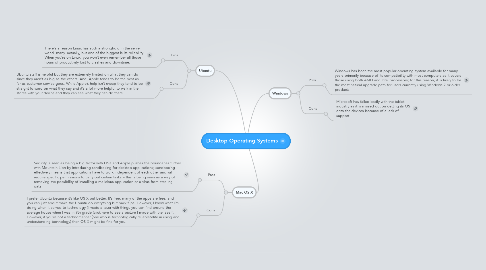
1. Ubuntu
1.1. Pros
1.1.1. There's a reason Linux has such a stronghold in the server world--many, actually, but one of the biggest is its reliability. When you're on Linux, you won't even remember all those hours of productivity lost to crashes and downtime.
1.2. Cons
1.2.1. Ubuntu staff is helpful but they are extremely limited on what they can do since they aren’t as big as the others. And, Apple tends to be the best as far as customer service goes. While Apple’s help isn’t cheap they tend to be straight forward on what they say and it’s a lot more helpful to walk in their stores with your device and they can see what they can do there.
2. Mac OS X
2.1. Pros
2.1.1. Security is seen as being a big factor with OSX and Apple pushes the boundaries further with Mountain Lion by introducing sandboxing for desktop applications; sandboxing effectively means that applications have to work independent of each other and will require specific permissions to carry out certain tasks – this is being seen as a way of removing the possibility of installing a malicious application or a virus from stealing data.
2.2. Cons
2.2.1. I prefer Ubuntu because it’s like OS X but better. It’s free, many of the apps are free, and you can just about make the Ubuntu do everything but back flips. However, I know what I’m doing when it comes to technology (I made a laser with things you can find around the average house when I was in 9th grade (click here to see a picture I made with the laser)). However, if you’re not a technomancer (one who is technologically reliable/elite in using and understanding technology) then OS X might be fine for you.
3. Windows
3.1. Pros
3.1.1. Windows has been the most popular operating system available for many years primarily because of its compatibility with most computers as it covers those using both AMD and Intel processors; for this reason, it is likely to be the most natural upgrade path for users currently using Windows 7 or older products.
3.2. Cons
3.2.1. Microsoft has failed badly with the tablet industry as it is missed out on getting its OS onto the devices because of a lack of support..
